On Measuring Peace and Peace Research Methods
Debates around measuring peace are certainly not new, yet they have increasingly taken on critical policy relevance, as a new global development policy framework is being negotiated, and as actors concerned with peace collectively engage to ensure the new framework encompasses these issues. My work around measuring peace has sought to engage three streams of policy, practice and scholarly work:
- ~ On the policy side, discussions are focused around how to conceptualise and measure peace as a goal, amongst the 17 proposed sustainable development goals (SDGs) being considered by member states in the Post-2015 Development Framework, and within the International Dialogue on Peacebuilding and Statebuilding (IDPS) or "New Deal" process, discussions focus around how countries affected by conflict measure progress out of conflict and fragility, towards resilience.
- ~ A related second stream of practice is the flourishing area of how to evaluate programming and policy for peacebuilding results, and connected to this – the question of how to ensure programming across all sectors factors in analysis of the conflict and political-economy context, to be conflict sensitive.
- ~ Third, is a more scholarly stream around research methods, and whether and how social science research that addresses questions of peace and conflict research is different than other social sciences, and based on what kinds of considerations.
Policy Processes on Measuring Peace
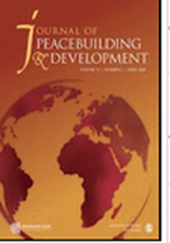
Critical evolutions in the peacebuilding-development praxis nexus: Crisis and Complexity, synergy and transformation
Journal of Peacebuilding and Development, V16: N2, 2021
Article - open access
Publisher website
Article - open access
Over the last 2 decades, the peacebuilding and development nexus has grown as a critical area of scholarship and practice. At the same time, the conflict landscape has evolved in complexity, incor- porating fragility, violence, and humanitarian crisis, presenting ever greater challenges for analysis, framing, and effective policy and practice responses. This article reflects on the paradigmatic shifts occurring and the new paradigms that are arising in response. The article argues that the complexity facing our fields demands inter-paradigm learning, pluralism, and synergy, and the political will to adapt and act in accordance with the transformative measures required to tackle the structural and systemic nature of these crises.
Peacebuilding-development nexus, Palgrave Encyclopaedia of Peace and Conflict Studies, eds., O. Richmond and G. Visoka G., London: Palgrave, 2021.
Publisher website
Journal of Peacebuilding and Development, V16: N2, 2021
Article - open access
Publisher website
Article - open access
Over the last 2 decades, the peacebuilding and development nexus has grown as a critical area of scholarship and practice. At the same time, the conflict landscape has evolved in complexity, incor- porating fragility, violence, and humanitarian crisis, presenting ever greater challenges for analysis, framing, and effective policy and practice responses. This article reflects on the paradigmatic shifts occurring and the new paradigms that are arising in response. The article argues that the complexity facing our fields demands inter-paradigm learning, pluralism, and synergy, and the political will to adapt and act in accordance with the transformative measures required to tackle the structural and systemic nature of these crises.
Peacebuilding-development nexus, Palgrave Encyclopaedia of Peace and Conflict Studies, eds., O. Richmond and G. Visoka G., London: Palgrave, 2021.
Publisher website
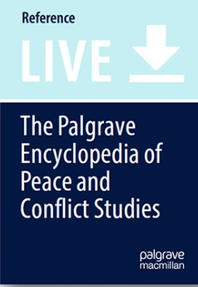
Peacebuilding-development nexus
Palgrave Encyclopedia of Peace and Conflict Studies
Erin McCandless, in O. Richmond and G. Visoka G. (eds), London: Palgrave, 2021
Publisher website
Peacebuilding and development intersections in scholarship and practice span disciplines, time and space, worldviews, and policy agendas and practice areas. This reflection examines the “nexus” through various paradigms of peacebuilding and development that have dominated scholarly thinking and international policy and practice, exploring the ways that they intersect with one another. Unsurprisingly, it reveals that the nature of the nexus is profoundly shaped by the orientation of each peacebuilding, or development, paradigm in focus. Specific paradigms depicting the nexus and orienting policy and practice are then discussed that frame actual and emergent areas of consensus and action in international politics.
Palgrave Encyclopedia of Peace and Conflict Studies
Erin McCandless, in O. Richmond and G. Visoka G. (eds), London: Palgrave, 2021
Publisher website
Peacebuilding and development intersections in scholarship and practice span disciplines, time and space, worldviews, and policy agendas and practice areas. This reflection examines the “nexus” through various paradigms of peacebuilding and development that have dominated scholarly thinking and international policy and practice, exploring the ways that they intersect with one another. Unsurprisingly, it reveals that the nature of the nexus is profoundly shaped by the orientation of each peacebuilding, or development, paradigm in focus. Specific paradigms depicting the nexus and orienting policy and practice are then discussed that frame actual and emergent areas of consensus and action in international politics.
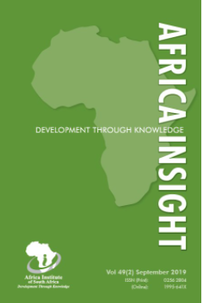
Beyond liberal and local peacebuilding: Alternatives for addressing the complexity of conflict and fragility in Africa
Africa Insight, 49(3) December 2020
Publisher website / email me for complementary copy
The search for more relevant and effective approaches to building and sustaining peace, preventing violent conflict and reducing fragility is on, with growing cognisance of the failures and limitations of liberal peacebuilding and the ‘local turn’. This paper explores critiques of these and lessons arising in the context of the ever-increasing complexity of the conflict-fragility-violence landscape. Three conceptual and practical framings are examined: endogenous hybridity; transformation; and resilient social contracts. These framings have emerged in the last decade in the peacebuilding field and wider interdisciplinary scholarship and policy arenas. The paper argues that these three framings reflect both realities and aspirations on the ground in Africa, and are giving rise to practical and relevant pathways that hold promise for achieving and sustaining peace.
Africa Insight, 49(3) December 2020
Publisher website / email me for complementary copy
The search for more relevant and effective approaches to building and sustaining peace, preventing violent conflict and reducing fragility is on, with growing cognisance of the failures and limitations of liberal peacebuilding and the ‘local turn’. This paper explores critiques of these and lessons arising in the context of the ever-increasing complexity of the conflict-fragility-violence landscape. Three conceptual and practical framings are examined: endogenous hybridity; transformation; and resilient social contracts. These framings have emerged in the last decade in the peacebuilding field and wider interdisciplinary scholarship and policy arenas. The paper argues that these three framings reflect both realities and aspirations on the ground in Africa, and are giving rise to practical and relevant pathways that hold promise for achieving and sustaining peace.
Agenda 2030 and the promotion of peaceful, inclusive societies
Among the myriad efforts to influence the shaping of Agenda 2030 to adopt direct measures to fulfill on the goals of peaceful and inclusive societies, the Civil Society Platform on Peacebuilding and Statebuilding (CSPPS) was an important player in seeking to ensure the inclusion of peacebuilding values and concerns. Below are several of our illustrative statements.
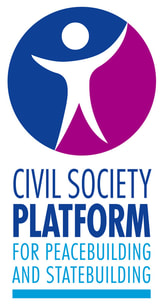
Post 2015, Goal 16 and Lessons on Indicators: Civil Society Perspectives from the New Deal Work on Indicators
Civil Society Platform for Peacebuilding and Statebuilding, February 2015.
Available for download here
Putting Sustainable Peace and Safe Societies at the Heart of the Development Agenda: Priorities for post-2015
Civil Society Platform for Peacebuilding and Statebuilding, September 2013.
Available for download here
Bringing peace into the post‐2015 development framework: A joint statement by civil society organisations
Civil Society Platform for Peacebuilding and Statebuilding, September 2012.
Available for download here
Civil Society Platform for Peacebuilding and Statebuilding, February 2015.
Available for download here
Putting Sustainable Peace and Safe Societies at the Heart of the Development Agenda: Priorities for post-2015
Civil Society Platform for Peacebuilding and Statebuilding, September 2013.
Available for download here
Bringing peace into the post‐2015 development framework: A joint statement by civil society organisations
Civil Society Platform for Peacebuilding and Statebuilding, September 2012.
Available for download here
Indicators to measure peacebuilding and statebuilding goals (PSGs) / New Deal
For two years I served as a civil society representative on the International Dialogue on Peacebuilding and Statebuilding (IDPS) / “New Deal“ Technical Working Group on Indicators. We were mandated to develop indicators to measure the Peacebuilding and Statebuilding Goals (PSGs), and after extensive political and technical dialogue at global and national levels, we produced a list of “Common Indicators” around these goals. These are still considered draft indicators, that g7+ countries are piloting. While Agenda 2030 is now in place, the below statements represent CSPPS positioning on how PSGs should be measured, and last, a journal article that describes and critically reflects upon the process.
Joint Submission to Consultation on Shared Indicators
Civil Society Platform for Peacebuilding and Statebuilding, January 2013.
Available for download here
Fulfilling New Deal Commitments: Recommendations from civil society on maximizing peacebuilding results
Civil Society Platform for Peacebuilding and Statebuilding, August 2012.
Available for download here
Developing Indicators for Peacebuilding and Statebuilding Goals: Employing a Peacebuilding Lens
Civil Society Platform for Peacebuilding and Statebuilding, October 2012.
Erin McCandless, Diana Chigas, and Peter Woodrow
Available for download here
Position Statement from the Third Meeting of the Working Group on PSG Indicators
Civil Society Platform for Peacebuilding and Statebuilding, September 2012.
Available for download here
Civil Society Platform for Peacebuilding and Statebuilding, January 2013.
Available for download here
Fulfilling New Deal Commitments: Recommendations from civil society on maximizing peacebuilding results
Civil Society Platform for Peacebuilding and Statebuilding, August 2012.
Available for download here
Developing Indicators for Peacebuilding and Statebuilding Goals: Employing a Peacebuilding Lens
Civil Society Platform for Peacebuilding and Statebuilding, October 2012.
Erin McCandless, Diana Chigas, and Peter Woodrow
Available for download here
Position Statement from the Third Meeting of the Working Group on PSG Indicators
Civil Society Platform for Peacebuilding and Statebuilding, September 2012.
Available for download here
Peacebuilding Evaluation and Conflict Sensitivity
"Conflict Sensitivity and Conflict Prevention"
Co-authored with Tony Karbo in (eds.) Erin McCandless and Tony Karbo, Peace, Conflict, and Development in Africa:
A Critical Reader and Compendium. Geneva: UN University for Peace, 2011.
This chapter includes excerpts from a number of publications that explore approaches to thinking about conflict prevention and conflict sensitivity and how they can contribute to enabling peace and human development. This editorial and related excerpts comprising this chapter can be accessed here and the full book, here.
Co-authored with Tony Karbo in (eds.) Erin McCandless and Tony Karbo, Peace, Conflict, and Development in Africa:
A Critical Reader and Compendium. Geneva: UN University for Peace, 2011.
This chapter includes excerpts from a number of publications that explore approaches to thinking about conflict prevention and conflict sensitivity and how they can contribute to enabling peace and human development. This editorial and related excerpts comprising this chapter can be accessed here and the full book, here.
"An Integrated Framework for Peacebuilding, Human Rights and Development: Reflections on Liberia’s Poverty Reduction Strategy"
Co-authored with Sakiko Fukuda-Parr in (ed.) Kenneth Omeje, War to Peace Transition: Conflict, Intervention and Peacebuilding in Liberia, Lanham, Maryland: University Press of America, 2008.
Like many countries emerging from violent civil war, Liberia had the urgent challenge of consolidating the fragile peace while simultaneously addressing deep and extreme poverty. Recognising the critical links between peacebuilding and development, the Government of Liberia and the UN in Liberia (including the UN Mission in Liberia – UNMIL – and the UN agencies) took steps to infuse peacebuilding concerns within the Poverty Reduction Strategy. This paper examines the Liberian experience with the aim of drawing lessons for how Poverty Reduction Strategy Papers can serve as potential integrated frameworks to address a range of security, governance, and economic/development issues that meet both peacebuilding and human rights concerns.
Co-authored with Sakiko Fukuda-Parr in (ed.) Kenneth Omeje, War to Peace Transition: Conflict, Intervention and Peacebuilding in Liberia, Lanham, Maryland: University Press of America, 2008.
Like many countries emerging from violent civil war, Liberia had the urgent challenge of consolidating the fragile peace while simultaneously addressing deep and extreme poverty. Recognising the critical links between peacebuilding and development, the Government of Liberia and the UN in Liberia (including the UN Mission in Liberia – UNMIL – and the UN agencies) took steps to infuse peacebuilding concerns within the Poverty Reduction Strategy. This paper examines the Liberian experience with the aim of drawing lessons for how Poverty Reduction Strategy Papers can serve as potential integrated frameworks to address a range of security, governance, and economic/development issues that meet both peacebuilding and human rights concerns.
Other key resources
- ~ Conflict Sensitivity: Topic Guide. Huma Haider. Birmingham, UK: GSDRC, University of Birmingham, 2014. Download Here.
- ~ Conflict Sensitivity Consortium
Peace Research Methods
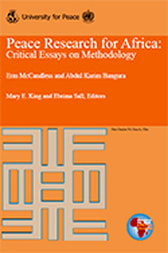
Peace Research for Africa: Critical Essays on Methodology
Co-edited with Abdul Karim Bangura Mary E. King and Ebrima Sall. Geneva: UN University for Peace, 2007.
Research in the field of peace and conflict studies needs to improve the quality and relevance of knowledge by and for Africa. This requires a healthy debate over appropriate research methodologies and epistemological approaches, links between empirical research, theory, policy and practice, and the ways in which peace and conflict research compares with other fields. Peace Research for Africa: Critical Essays on Methodology offers a review of the state of peace and conflict studies amidst the wider educational and political economy context in Africa. It reviews conceptual foundations of peace studies, and critically reflects upon research perspectives, paradigms and methodologies with particular suitability for peace research and relevance in and for Africa, with attention to the contributions of African theorists. This book is freely downloadable on the publisher's website - the UN-affiliated University for Peace (UPEACE), and here.
"Towards a Theory, Method and Practice of Appreciative Inquiry for Use in Complex Peacebuilding and Development Contexts"
Co-authored with Mary Hope Schwoebel, in (eds.) Cynthia Sampson, Mohammed Abu-Nimer, Claudia Liebler, and Diana Whitney,
Positive Approaches to Peacebuilding: A Resource for Innovators. Washington, D.C.: Pact Publications, 2003.
This chapter discusses the potential applications of Appreciative Inquiry (AI) in complex peacebuilding and development settings and also in facilitating theory building and practice at the nexus of these two fields. Epistemological and methodological critiques of AI are addressed, particularly as they pertain to contexts of structural and direct violence and poverty. Conclusions consider how AI might be adapted to create positive peace and positive social change.
Co-authored with Mary Hope Schwoebel, in (eds.) Cynthia Sampson, Mohammed Abu-Nimer, Claudia Liebler, and Diana Whitney,
Positive Approaches to Peacebuilding: A Resource for Innovators. Washington, D.C.: Pact Publications, 2003.
This chapter discusses the potential applications of Appreciative Inquiry (AI) in complex peacebuilding and development settings and also in facilitating theory building and practice at the nexus of these two fields. Epistemological and methodological critiques of AI are addressed, particularly as they pertain to contexts of structural and direct violence and poverty. Conclusions consider how AI might be adapted to create positive peace and positive social change.
